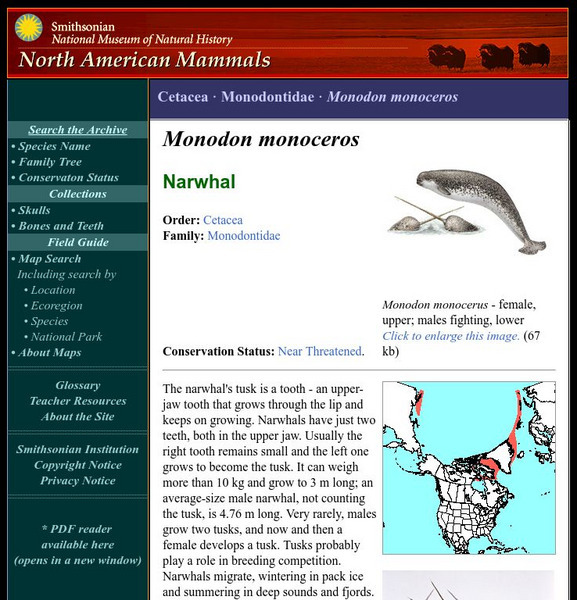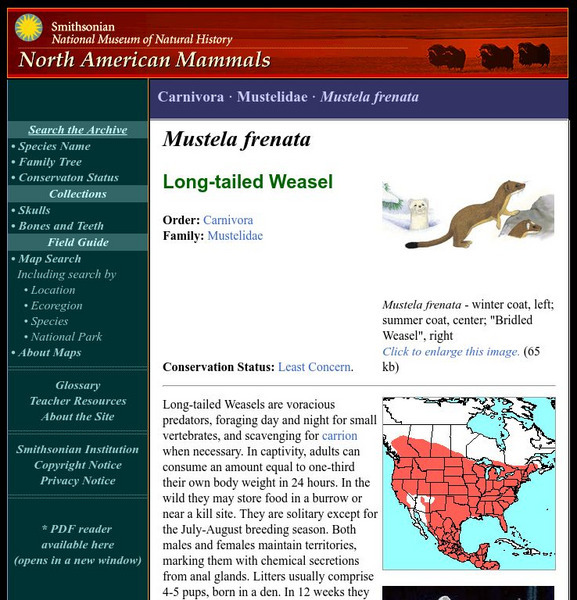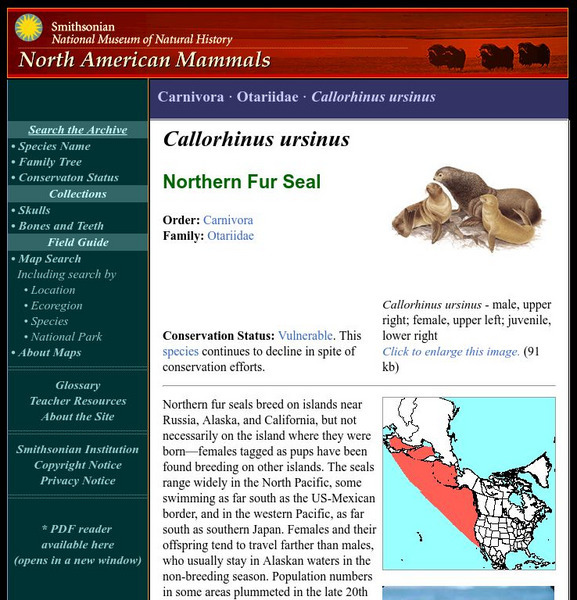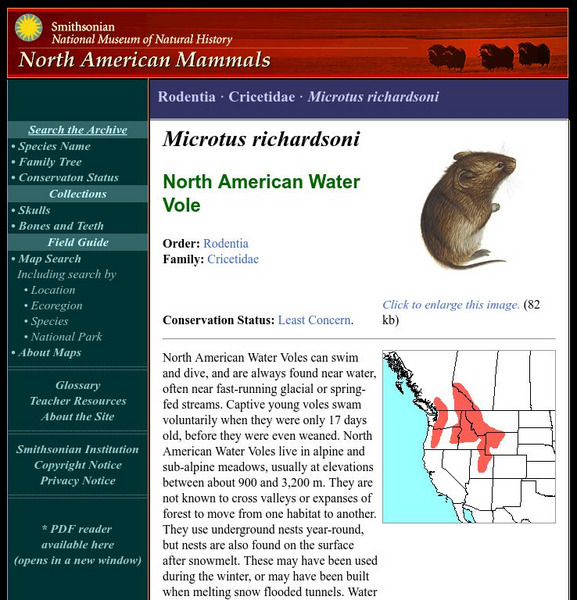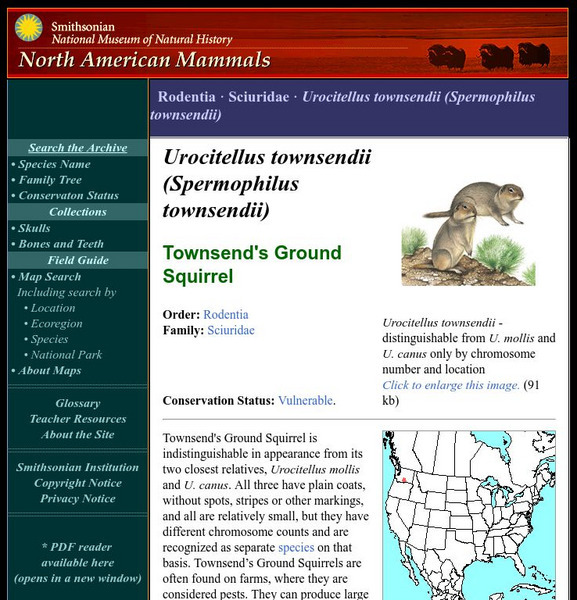Hi, what do you want to do?
Smithsonian Institution
National Museum of Natural History: American Mammals: Narwhal
The narwhal's tusk is a tooth - an upper-jaw tooth that grows through the lip and keeps on growing. Narwhals have just two teeth, both in the upper jaw. Learn more about the Monodon monocerus, more commonly known as a Narwhal, in this...
Smithsonian Institution
National Museum of Natural History: American Mammals: Long Tailed Weasel
Long-tailed Weasels are voracious predators, foraging day and night for small vertebrates, and scavenging for carrion when necessary. In captivity, adults can consume an amount equal to one-third their own body weight in 24 hours. Learn...
Smithsonian Institution
National Museum of Natural History: American Mammals: Northern Fur Seal
Northern fur seals breed on islands near Russia, Alaska, and California, but not necessarily on the island where they were born females tagged as pups have been found breeding on other islands. The seals range widely in the North...
Smithsonian Institution
National Museum of Natural History: American Mammals: Sperm Whale
Sperm whales can dive deeper than 1.6 km and stay under for 90 minutes, although shorter, shallower dives are more usual. Learn more about the Physeter catodon (Physeter macrocephalus), more commonly known as a Sperm Whale, in this...
Smithsonian Institution
National Museum of Natural History: American Mammals: North American Water Vole
North American Water Voles can swim and dive, and are always found near water, often near fast-running glacial or spring-fed streams. Captive young Voles swam voluntarily when they were only 17 days old, before they were even weaned....
Smithsonian Institution
National Museum of Natural History: American Mammals: Taiga Vole
Taiga Voles eat mostly grass, but include some other plant matter in their diets. They inhabit forest habitats near streams and bogs, using both underground and surface runways. Learn more about the Microtus xanthognathus, more commonly...
Smithsonian Institution
National Museum of Natural History: American Mammals: Northern Elephant Seal
As is often the case in species where males compete to mate with as many females as possible, northern elephant seal males are much larger than females (1,800 kg versus 650 kg on average). Competitions can be battles, but more often...
Smithsonian Institution
National Museum of Natural History: American Mammals: Long Legged Myotis
Long-legged myotis typically occupy mountainous or relatively rugged areas. They often live in coniferous forests, although they are sometimes found in oak or streamside woodlands, and even deserts. Learn more about the Myotis volans,...
Smithsonian Institution
National Museum of Natural History: American Mammals: Ringtail
Ringtails are nocturnal, cat-sized carnivores. They are good climbers and are found in habitats that range from dry canyons to wet woodlands, in highland and lowland terrain. Learn more about the Bassariscus astutus, more commonly known...
Smithsonian Institution
National Museum of Natural History: American Mammals: Western Heather Vole
Western Heather Voles live in mountains, near or above the timberline. Where high-elevation forests have been clear-cut, they have been seen at lower elevations. Learn more about the Phenacomys intermedius, more commonly known as a...
Smithsonian Institution
National Museum of Natural History: American Mammals: Spotted Seal
Spotted Seals breed in isolated pairs rather than large groups. They congregate in breeding areas, but each pair keeps its distance. Learn more about the Phoca largha, more commonly known as a Spotted Seal, in this easy-to-read species...
Smithsonian Institution
National Museum of Natural History: American Mammals: Ribbon Seal
Ribbon Seals are rarely seen on land. In late winter and spring they are on pack ice, 100-200 km offshore, where they molt, mate, and pup. Learn more about the Phoca fasciata, more commonly known as a Ribbon Seal, in this easy-to-read...
Smithsonian Institution
National Museum of Natural History: American Mammals: Merriam's Shrew
Merriam's Shrew is noted for its predilection for dry habitats. It is most often found in sagebrush steppe, but also in grassland, brushland, and woodland, at elevations from 200 m to 2,900 m. Learn more about the Sorex merriami, more...
Smithsonian Institution
National Museum of Natural History: American Mammals: Spiny Pocket Mouse
The Spiny Pocket Mouse is somewhat shaggy. Its spines, which are mostly on the rump, are not nearly as stiff as porcupine quills. Learn more about the Chaetodipus spinatus, more commonly known as a Spiny Pocket Mouse, in this...
Smithsonian Institution
National Museum of Natural History: American Mammals: Pribilof Island Shrew
The Pribilof Island Shrew lives in maritime tundra on St. Paul Island, and almost nothing is known about its biology. Learn more about the Sorex pribilofensis, more commonly known as a Pribilof Island Shrew, in this easy-to-read species...
Smithsonian Institution
National Museum of Natural History: American Mammals: Piute Ground Squirrel
Piute Ground Squirrels are adapted to desert life. Their kidneys efficiently conserve water, and they are able to withstand high temperatures. Learn more about the Spermophilus mollis, more commonly known as a Piute Ground Squirrel, in...
Smithsonian Institution
National Museum of Natural History: American Mammals: Rock Squirrel
Rock squirrels, with their long, bushy tails, look very much like tree squirrels, but seldom climb trees. They are most commonly found in rocky habitats: canyons, cliffs, and hillsides. Learn more about the Spermophilus variegatus, more...
Smithsonian Institution
National Museum of Natural History: American Mammals: Thirteen Lined Ground Squirrel
Thirteen-lined Ground Squirrels are often seen standing on their hind legs on roadsides or other places where grass is mowed, such as lawns, golf courses, or cemeteries. The squirrels probably once lived in short-grass prairie, and some...
Smithsonian Institution
National Museum of Natural History: American Mammals: Townsend's Ground Squirrel
Townsend's Ground Squirrel is indistinguishable in appearance from its two closest relatives, Spermophilus mollis and S. canus. Learn more about the Spermophilus townsendii, more commonly known as a Townsend's Ground Squirrel, in this...
Smithsonian Institution
National Museum of Natural History: American Mammals: Uinta Ground Squirrel
Uinta Ground Squirrels can live seven years or longer, but few live more than four years. Predation is an important factor. Learn more about the Spermophilus armatus, more commonly known as a Uinta Ground Squirrel, in this easy-to-read...
Smithsonian Institution
National Museum of Natural History: American Mammals: Merriam's Ground Squirrel
Merriam's Ground Squirrels live in high desert habitat dominated by big sagebrush, western juniper, and greasewood, and are also found in grasslands and agricultural lands. They eat grasses and forbs. Learn more about the Spermophilus...
Smithsonian Institution
National Museum of Natural History: American Mammals: Rock Pocket Mouse
As their name indicates, Rock Pocket Mice dwell in rocky habitats, and only rarely live in areas with sandy or silty soils. Their inconspicuous burrows are located near or under rocks, in rocky gulches or canyons, or near boulders. Learn...
Smithsonian Institution
National Museum of Natural History: American Mammals: New England Cottontail
New England Cottontails forage alone, and groom themselves but not each other. They feed on grasses and clover in the summer, and when those are not available, turn to twigs and forbs. Learn more about the Sylvilagus transitionalis, more...
Smithsonian Institution
National Museum of Natural History: American Mammals: Northern Bog Lemming
Northern Bog Lemmings have a large geographic range, but they are seldom encountered, and the reason for their apparent scarcity is not known. Their preferred foods - sedges and grasses - are abundant, and they do not have very limiting...





